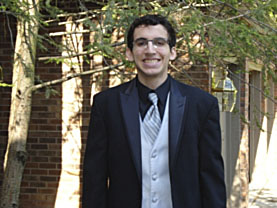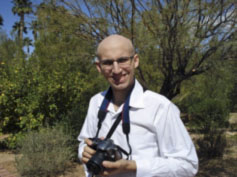2/9/2020 Update: In September 2019 , Steven was recently diagnosed with two more cancers (now, the total is four) and is now fighting Renal Cell Carcinoma and a Soft Tissue Sarcoma. He is currently in treatment.
This story will introduce you to the AYA community. AYA stands for Adolescent, and Young Adult. Because it is nestled between children and adults, this population of cancer patients is often overlooked and underserved. It does not get the attention or coverage that it deserves. Four Square Team Captain

Steven, Nick, and Phil on the island of Santorini, Greese July, 2005 (seven months before diagnosis)
“Your son Steven has Stage 4 Osteosarcoma… We are going to do everything we can to save him… From this day forth your lives will never be the same.”
Those words still ring in my ears. Seven years ago, our energetic and loving son Steven was diagnosed with cancer. Steven was 15 years old at the time of his first diagnoses. He battled cancer with, according to his oncologist, “the most rigorous forms of chemotherapy available” for young patients with Osteosarcoma, and “… no adult could survive this type of chemo.” He had radiation to shrink the tumor, and two spine surgeries
to remove the tumor and fuse his spine. You see, Steven’s Osteosarcoma was located in Lumbar 4 region of his spine. In addition, the Osteosarcoma had metastasized in his lungs, hence the term Stage Four Cancer.
After ten months of treatment Steven was declared Cancer Free!
So was this the end of the journey? No.
After treatment for his osteosarcoma, Steve grew stronger and healthier. He returned to high school and graduated with his peers. He started college and continued to participate in intramural sports and Greek folk dancing. He was looking handsome as ever. Life was good.
And then the bottom fell out: a week after Thanksgiving, during a follow up blood test, we were informed that secondary Acute Myelogenous Leukemia had developed in our son’s body. We were told that the survival rate was very poor. We were told that there were two options, do nothing or have a risky bone marrow transplant (BMT). We wanted to examine research to help make an intelligent decision but were informed that there was little information and research available for Steven’s age group. Imagine, your son is nineteen years old, fighting cancer for a second time and there is little information.
Steven boldly commented to the doctor, “So it’s really a crap shoot!”
Despite our deep concern over on son’s condition, our wonderful pediatric medical team provided us with a plan of action: (1) be admitted into the hospital (Rainbow, Babies & Children’s Hospital of Cleveland) as soon as possible; (2) prepare for a rigorous chemotherapy treatment to wipe out the cancer and put him in remission, which also meant eradicating his immune system; and (3) find a stem cell donor. Our entire family and community rallied around us. Christmas, New Years, and Valentine’s Day were spent in the hospital.
During treatment Steve was housed in a large hospital room specifically for transplant patients. He brought in his play station, flat screen TV (that he went out and bought the day he learned about his diagnosis). I brought in a folding table for family dinners and a
coffee pot (I needed my home brew to help me keep my sanity). Our hospital refrigerator was filled with foods that Steve could tolerate as well as items not available in the hospital cafeteria. We decorated his room with items from home and posters from family and friends. Our favorite poster that loomed overhead was of Mohammed Ali standing over Sonny Liston after knocking him out! Talk about a motivational photograph!
For three months Steven was treated with chemotherapy. With survivor instincts in place and the blessing of God he coped very well to the rigorous treatments. In fact the  dietitian was amazed at his ability to continue eating despite the drugs he was receiving. He kept asking for salty peanuts. The entire medical staff was pleased (and a little jealous) with his high caloric food selection. We just couldn’t believe the amount of Planters peanuts he consumed!
dietitian was amazed at his ability to continue eating despite the drugs he was receiving. He kept asking for salty peanuts. The entire medical staff was pleased (and a little jealous) with his high caloric food selection. We just couldn’t believe the amount of Planters peanuts he consumed!
During the time period where the chemotherapy was doing its job of eradicating Steven of his immune system and the leukemia, we learned that our sons Phil and Nick were not a match. We then began the process of organizing bone marrow drives. Again, our community embraced our efforts and fully understood the importance of registering to become a potential donor. (As you read this blog, I hope you are a member of the Bone Marrow Registry, http://m.marrow.org/) Interestingly, our donor didn’t come from within our “community” but from outside; a complete stranger. God sent this young man (age 33 years old) to save our son. What a blessing!
And so, as we prepared for this chapter in our son’s life, we needed to reach within our spiritual selves and pray. With the permission and support of his medical team we visited a Greek Orthodox Monastery in Arizona, where we prayed with a devout priest known for his spirituality. It was a very touching time in our lives. We felt everyone’s prayers and love.
Just prior to transplant Steven’s blood type was changed to prevent the donor’s antibodies to attack his blood stream. So with the help of a large portable machine that looked like something for dialysis, Steven’s blood type was changed from A negative to O positive.
On transplant day, our family and priest prayed over Steven as he was being prepared by the medical team. Steven needed to be sedated to avoid the risk of an allergic reaction. Steven slept, and we prayed and cried as we watched the stem cells flow through a tube and enter our son through one of his ports. The stem cells were contained in a zip lock style sandwich sized plastic bag. Funny how a container that looked so small and seemingly inconsequential could hold something of such great importance.
After approximately thirty days Steven was permitted to go home with a host of prescriptions for immune suppression, antifungals and antibacterials to protect his infant-like immune system. Steven’s diet was limited to foods prepared and cooked at home and under the most sanitary conditions. His marching orders included (1) wear a mask in public; (2) don’t eat in a restaurant, especially a buffet; (3) take all your medications; (4) eat and drink cooked healthy foods; (5) and call us at the first sign of any health problem. We were warned to look for manifestations of GVHD (graft vs. host disease), a common side effect of BMT’s (bone marrow transplants).
GVHD can present itself on the skin (inside and out), gut, liver, lungs, eyes: in other words, just about anywhere on or in the human body. So it is very important for the patient to immediately contact his doctor at the sign of anything different. Not being proactive could result in developing a life threatening condition.
A transplant recipient needs a “little” GVHD, but not too much. It is important for the body to adjust itself to a “new you” with some minor medical occurrences (hence little GVHD), but not so much that it is life threatening. Fortunately, Steven had only two medically frightening and life threatening situations that required emergency care. For the sake of brevity I will not go into the details. Suffice to say GVHD presented itself in the most unusual and frightening manner. In fact, in the last four years health problems caused Steven to be admitted into the hospital, drop out of college twice, change career goals, reevaluate life, and come to grips with the reality that a two-time cancer survivor and bone marrow transplant recipient will live a lifetime with chronic health problems.
Chronic health problems interfere with daily life. People like Steven visit the doctor more often, continue to take immune suppressants, antibacterial and antifungal medications, as well as psychotropic drugs for anxiety and pain. This is the reality of being a young cancer survivor!
At the age of 22 years, he is a college sophomore at Cleveland State University. He believes he has found his niche. The future looks better.
Being a young adult cancer survivor means standing up and pushing forward with life. Nothing is taken for granted. Friends and family are cherished. The common phrase “one day at a time” has a whole new meaning.
As a YA (young adult) cancer survivor and BMT (bone marrow transplant) recipient, Steven faces the reality of regular follow-up medical appointments, lurking infections, and the possibility of heart or lung problems. This means that he will always need good health care once he is no longer eligible for our medical plan.
Our journey is different from Steven’s. As parents, we feel blessed to have three great sons, a wonderful family, and supportive community. We too take each day as it comes. It is the little things in life we appreciate and enjoy.
We hate the fact that we have friends who have lost their children (young and old) to cancer. We are angry that a cure isn’t available. We are frustrated knowing that the current treatments for cancer put our children in harm’s way with the risk of developing a secondary cancer or other health problems.
A CURE MUST BE FOUND!
- Each day 36 children (0-14 years) are diagnosed with cancer in the USA
- Each day 175,058 children, adolescents and young adults are diagnosed with cancer in the world.
- Childhood Cancer cannot be prevented.
- Each day 70,000 AYA’s (adolescents and young adult – ages 15-39 years) are diagnosed with cancer.
- Rate of survivorship for AYA’s with cancer have not improved since the 1970’s.
- Life threatening illnesses or secondary cancers will impact over 19% of childhood cancer survivors in their teens or young adult years.
- There is a lack of children and AYA’s participating in clinical trials.
- There is a lack of funding (in 2006 only 3% of the National Cancer Institute’s budget went to pediatric cancer!!!).
- AYA’s are more likely that any other age group to ignore health symptoms that can cause devastating and life threatening illnesses like cancer.
- WE NEED MORE RESEARCH TO SAVE OUR CHILDREN, ADOLESCENTS AND YOUNG ADULTS.
So, my friends I thank you for this opportunity to tell my story about our journey with cancer. Life is what you make of it. And for me it is about helping to get the word out that a CURE is needed. 
The motto of the Steven G AYA Cancer Research Fund is this:
We will not rest until there is a cure!
Fight! Conquer! Cure!!!
With the help of his friends, Steven made it to the top of a Glacier in Montana one year after his transplant.
Author: Angie Giallourakis
Related Stories:
NCI has more informationavailable (bulletins and newsletters), as well as a library of videos devoted to the AYA population.
Many childhood cancer survivors become advocates when they enter AYA status. Here, Carolyn Coveney, a ten year survivor, produced a video about childhood cancer.
Carson Leslie lost his battle with cancer at age seventeen, but before he died he wrote, “Carry Me,” a book in which Carson allows the reader to see his day to day struggle and how he wanted to be able to interact with all the people with which he came in contact.
At age thirteen, Melinda Marchiano was diagnosed with Hodgkin’s lymphoma. At sixteen, she wrote “Grace,” which is an inspirational and humorous book about her journey. She is in college and continues to be very active in advocacy for childhood cancer.



















My name is Tammie Garland. My son was diagnosed with AML Aug 21, 2012. He turned 17 the next week. He was hospitalized from then until his death January 2 of this year.
We now are in the beginning stages of creating a non profit organization. We have certain goals, but my concern is a cure and more help for families of AYA’s.
Any help you can give is greatly appreciated.
Sincerely,
Tammie Garland
Hi Tammie,
Please feel free to contact me at angie@fightconquercure.com.
Sincerely,
Angie
Hi Danielle,
I would be happy to share information with you. Let’s communicate!!!
Please email me at
angie@fightconquercure.com so we can arrange to speak on the telephone.
Sincerely,
Angie
Tammie,
I apologize for my rudeness for not expressing my sympathy to you and your family. I cannot imagine the level of grief you and your family are expressing. My heart goes out to you! A very good friend of mine lost her son to cancer a little over a year ago..and we still grieve over his passing.
Please know that I am willing to help you with your mission to help families of AYA’s.
If you email me, we could arrange to speak on the telephone if you wish.
Please take care.
Sincerely,
Angie Giallourakis
Inspiring, please keep looking for a cure! Sounds like you are a wonderful advocate for your son, he’s lucky for that as was I for my incredible family and friends that helped keep me mentally healthy. I was treated for AML at age 15 and then BMT two years later. Reach out to me if I can spread your mission in Chicago.
Pingback: Where are you now, Rock Hudson? | Four-Square Clobbers Cancer
Pingback: Where are you now, Rock Hudson? | Grandparents In Action
Thank you for helping spread awareness. I have been a PAYA hem/onc BMT nurse for over 30 years. I’ve witnessed the journey of many. I thank you for your voice. Only in the telling of stories will we build awareness.
Hugs Suzanne
Thank you for all you do too Suzanne. Checkout http://www.CAC2.org and consider joining us!
Angie.
This is awesome